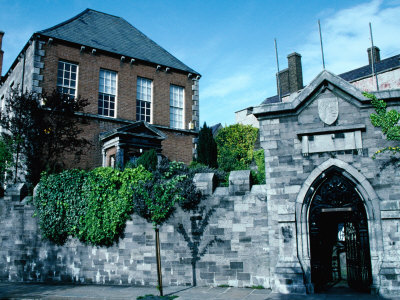Narcissus Marsh’s best known achievement – the idea of founding a public library – seems to have emerged gradually from his concerns on education. While he was Provost of Trinity College, Dublin, it is said that he ‘observed how difficult it was to use the library there’ (http://www.marshlibrary.ie/about/narcissus-marsh/) and complained in his diary of ‘the ill education that the young Scholars have before they come to College whereby they are both rude and ignorant’ (ibid). During his tenure, though he made ‘the revision of the regulations for administering the College library’ (ibid), nonetheless, in May 1700, he still complained in a letter to his friend in England of not having ‘any convenient room to hold an ordinary study of books’ (ibid) even at his position. When Marsh consulted his idea of a public library in the same letter, it was the time in England that saw ‘public libraries had sprouted up in industrious cities such as Bristol, Ipswich and Norwich’ (http://chooseireland.com/dublin/marshs-library/). This momentum has only began in 1653, when Chetham’s Library was founded in Manchester, as the first public library in Britain ‘under the will of Humphrey Chetham (1580-1653), a prosperous… textile merchant, banker and landowner.’ (http://www.chethams.org.uk/history.html). In other words, emergence of public library could be accounted as a part of impact and effect caused by the Industrial Revolution to the society as a whole. Before the foundation of Chetham’s Library, it is said that ‘there was no facility for independent study in the north of England’ (ibid) and such facilities and knowledge had been mostly dominated by the college libraries like Oxford and Cambridge. In his will of 1651, Humphrey Chetham made sure that his librarians should be instructed ‘to require nothing of any man that cometh into the library’ (ibid).
In 1701-03, Archbishop Marsh established the library ‘furnishing it with his own collection of books and by the purchase of the collection of Edward Stillingfleet’ (http://www.marshlibrary.ie/about/narcissus-marsh/), who became the first librarian of Marsh’s Library. It was built on ‘St. Patrick’s Close, almost hidden behind St. Patrick’s Cathedral’ (http://chooseireland.com/dublin/marshs-library/) in Dublin City Centre. The concept of a public library – ‘allowing ordinary people access to expensive books for free — was relatively radical’ (ibid) so that its building was designed to accommodate special rooms called the cages, where ‘visitors were locked in while reading one of the libraries more expensive titles, to prevent stealing’ (ibid). One of the most interesting things about Marsh’s Library for modern visitors is that it ‘is still a library but has not added new books since the 18th century’ (ibid) so that visitors could be ‘treated to an experience of an 18th century library (for) very little has changed since the library first opened’ (ibid), which involves not only the collection of books but also ‘Both the layout and furnishings of the library — including the dark oak bookcases, seats and shelves’ (ibid).
 |
| Marsh's Library For reading the text in full: http://wrex2009.wordpress.com/2013/12/21/marshs-library/ |
No comments:
Post a Comment